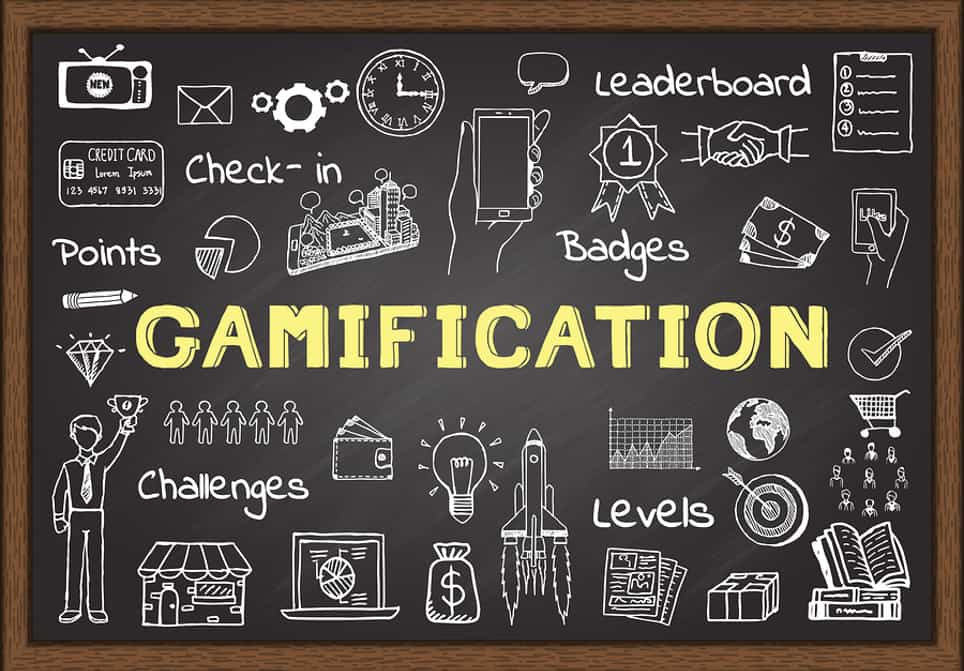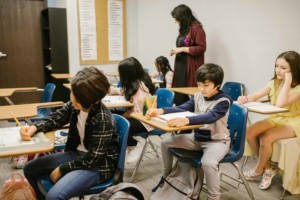1Up on Grades

By Mitch Weisburgh
This is the 8th in a series on the use of leaderboards and other strategies to encourage students to reflect on their performance.
This interview about leaderboards and competency-based learning features a conversation between three individuals who are active in the game-based learning movement.
Mitch Weisburgh
Nobody likes taking tests or getting graded in schools. Yet 97% of students play video games, playing for an average of over 10 hours a week, and games are constantly testing and assessing. Many games even publicly display how the players are doing; while schools are discouraged from posting test results for students. But then teachers start adding scoring and leaderboards to quiz-like activities to their classes, and reports are that the students love it.
What’s with that?
Ryan Schaaf
Competition is one of the fuels of innovation. In fact, competition exists in just about every facet of our lives. Due to globalization and the new digital landscape, we are in competition with just about everyone–for more money, a better job or to just be the very best.
Education is no different–many students strive to do their very best because they enjoy the gratification success offers them. However, specifically in education, demonstrating student success may be seen as gloating or offering the spotlight unfairly to only the students that receive good grades. In some cases, this spotlight can also be seen as a violation of student privacy.
In digital games and instances of gamification, leaderboards do not receive the same type of scrutiny. A leaderboard showcases the accomplishments and contributions of its participants. Leaderboards represent a mechanism for educators to showcase students that have mastered certain challenges without the stigma that is associated with grades.
Jeff Borden
I’d recommend watching this short video to get an understanding of how to artfully dance between the lines of competition with others, with self and leaderboards through grading. If you imagine turning a gradebook into a progress board, see how quickly it brings the conversation back to positively reinforce work and effort in addition to outcome and product.
My title includes “innovation” in the middle. Researchers like Dyer (The Innovator’s DNA) suggest that the key to innovation is associative thinking. In other words, creativity and innovation come from bringing outside contexts to your context. This is an area where I believe education has struggled. There is a lot we know about brain science that is not applied yet to education. We know more about organizational communication than is used to foster better educational outcomes. And we know a lot from game research about motivation, engagement and promoting a safe place to fail that we do not apply to learning content. Leaderboards are the tip of the iceberg but are a great (and relatively safe) place to start.
Mitch
Assessment should have multiple goals: motivation, providing feedback to the learner and educator, capturing what the student has learned or the teacher has taught.
Leaderboards reflect what participants or students do and/or what they have accomplished, and also hold students accountable to their class, peers and teachers. These practices contrast with the traditional age-based and time-based way of grouping students. A lot of school is based on time. You advance in grade after a school year. A college class consists of so many Carnegie units.
What’s keeping that going? What movements have you seen that advance students on what they know and convert over to competency-based learning instead of time-based advancement?
Ryan
Mastery of content, skills and processes should be the ultimate goal of every learner. Unfortunately, schools can’t afford to wait for every student to master every single learning experience. There is far too much curriculum to cover and the other students that have already mastered the learning experience will grow bored.
Competency-based learning challenges learners to become masters of a skill or topic before they move on to the next one. Gaming elements such as digital badging, leaderboards, and performance monitoring demonstrates students have mastered the content by competing against themselves to perform their very best. Leaderboards and performance monitoring are but small elements of a competency-based learning approach.
Jeff
Carol Dweck’s work on Mindset, and now dozens of other researchers, have tied growth-mindset’s characteristics such as grit and tenacity into the importance of believing one is capable of learning. Leaderboards and performance monitoring can leverage growth characteristics by encouraging students to compete against themselves to constantly improve.
Mitch
Jeff, do you see leaderboards as supplemental to education, or will leaderboards become higher-stake? Will they become the way students (are allowed to) progress to more advanced skills instead of the current methods of grading, age-based cohorts, and seat-time?
Jeff
I was sitting between two game CEO’s at a dinner a few years ago. They both started talking about games their companies offered, and how students achieved better grades and outcomes than classes not using the games. But they couldn’t get any schools to adopt it. Why? Because the teachers gave up too much seat time and control to the game.
The moral of the story is that any innovation in education will struggle once you get past the early adopters unless you really show the return on investment (ROI), AND train the heck out of it; game-based learning and competency-based learning are a whole new mindset for learning. Thinking that they will supplant grades and grading anytime in the near future seems…optimistic.
Mitch
We talk about game-based learning and gamification. Leaderboards, micro-certification, points and rewards are all aspects of gamification, but they really aren’t game-based learning. They are game-like mechanisms that help individuals measure progress. Perhaps they are a prequel to educational transformation.
Ryan
Gamification will continue finding new niches in society. We are already seeing aspects such as leaderboards, reward systems, badging and experiencing storyline narratives in business, marketing, advertising and consumerism. In education, competency-based learning (CBL) is a trend with a lot of momentum.
CBL has the potential to change the mindset of education to develop not only content experts but generalists that have diverse skill-sets. CBL is using many elements of gamification such as badging, leaderboards and performance monitoring. As for game-based learning, it has been around for 50 years and is not going away anytime soon. The stigma of learning through games is its real hurdle to jump.
Mitch
For over 100 years, we’ve been keeping students together by age, grading them to separate winners from losers, and teaching in classrooms designed during the industrial age. We are starting a transition to competency-based learning with leaderboards and performance monitoring, but as Jeff says, this will take time and lots of professional development. It’s as much change management as technological innovation. And hopefully, at the same time, we can move beyond traditional content and make learning playful, and more in line with the way the brain is designed to learn.
For more, see:
- The Role of Performance Monitoring in Competency-Based Education
- Motivating and Monitoring Performance: 6 Recommendations
- To Leaderboard or Not: The Art of Motivating and Monitoring Performance
Jeff Borden is the Chief Innovation Officer at Saint Leo University and has been promoting and using Alternate Reality (Games) Learning Experiences (ARLE) to promote better education for two decades.
Mitch Weisburgh is a co-founder of Games4Ed.org, a nonprofit working to increase the use of game-based learning, and a co-founder of ThinkZone Games, a startup education game aggregator.
Ryan Schaaf is the Assistant Professor of Technology at Notre Dame of Maryland University, director at international thinktank InfoSavvy21 and author of several books on gamification and edtech.







0 Comments
Leave a Comment
Your email address will not be published. All fields are required.